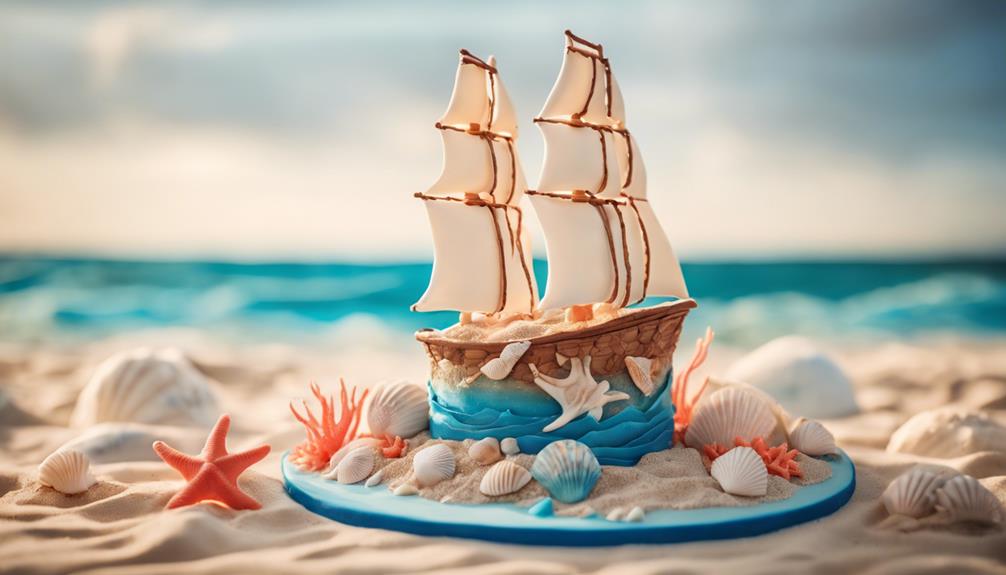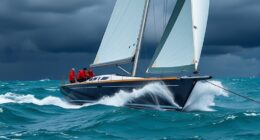If you're curious about the biggest sailboat in the world, search no more than Sailing Yacht A. This impressive vessel measures a staggering 142 meters (465 feet) and stands as a symbol of luxury and innovative design. You'll find its three towering 100-meter carbon fiber masts and sleek lines truly remarkable. Following closely is Koru, at 127 meters (417 feet), commissioned by Jeff Bezos. These majestic vessels aren't just about size; they represent the cutting-edge of engineering in the maritime world. Discovering more about these extraordinary yachts will surely broaden your appreciation for sailing's grand legacy.
Key Takeaways
- The largest sailing yacht in the world is Sailing Yacht A, measuring 142 meters (465 feet) with three 100-meter carbon fiber masts.
- Koru, commissioned by Jeff Bezos, is the second-largest sailing yacht at 127 meters (417 feet), featuring luxurious amenities and tall masts.
- Black Pearl, measuring 106 meters (348 feet), boasts advanced solar technology and a unique rigging system for rapid sail deployment.
- EOS, at 93 meters (305 feet), is known for its luxurious design and advanced navigation technology, highlighting modern sailing innovations.
Overview of Largest Sailboats
When exploring the world of sailing, you'll find that the largest sailboats, like Sailing Yacht A and Koru, showcase remarkable engineering and luxury on the open seas.
Sailing Yacht A stands out as the largest sailing yacht in the world, measuring an impressive 142 meters (465 feet). Its three towering 100-meter unstayed carbon fiber masts contribute to its striking silhouette and performance. With a gross tonnage of over 12,000 GT, it offers an unparalleled experience for those aboard.
Following closely is Koru, the second-largest sailing yacht, coming in at 127 meters (417 feet). Commissioned by Jeff Bezos, Koru boasts three masts that soar over 230 feet tall, redefining luxury sailing.
Other notable contenders include Black Pearl, measuring 106 meters (348 feet) and equipped with advanced solar technology, and EOS, at 93 meters (305 feet), which is renowned for its luxurious amenities.
Each of these yachts reflects a commitment to innovation and elegance, pushing the boundaries of what the largest sailing vessels can achieve. Whether for leisure or exploration, these majestic sailboats truly elevate the sailing experience.
Historical Significance of Sailing Vessels

Sailing vessels have played an essential role in shaping maritime history, serving not only as means of transportation but also as symbols of innovation and adventure. The historical significance of sailing ships is evident in their impact on trade, exploration, and military endeavors.
For instance, the Vasa, a Swedish warship from the early 1600s, sank on its maiden voyage, illustrating the engineering challenges of the period while becoming a preserved museum ship that tells a story of ambition and failure.
In the 19th century, the Great Republic emerged as the largest wooden sailing ship of its time, emphasizing advancements in shipbuilding techniques. Similarly, the seven-masted schooner Thomas W. Lawson, built in 1901, represented the pinnacle of design before the shift to motor vessels.
The France II, with its unique three-island deck design, showcased innovative approaches in 1912, while the barque Sedov continues to serve as a naval training vessel, linking contemporary sailors with nearly a century of maritime history.
Each of these vessels reflects the evolution and enduring significance of sailing ships throughout history, reminding you that the sea has always been a canvas for human ingenuity.
Engineering Marvels in Design

Modern sailing yachts showcase engineering marvels that blend cutting-edge technology with breathtaking design, pushing the boundaries of what's possible on the water. As you explore these magnificent vessels, you'll appreciate the innovative work of naval architects who've redefined luxury and performance.
Consider these stunning features:
- Sailing Yacht A: At 142 meters, it boasts three 100-meter unstayed carbon fiber masts, showcasing exceptional structural integrity.
- Koru: Formerly known as Y721, this 127-meter yacht has a steel hull and aluminum superstructure, making it the tallest sailing yacht with masts over 230 feet.
- Black Pearl: With its solar power capabilities and a unique rigging system, this yacht can deploy over 31,000 square feet of sail in under seven minutes.
- Aquijo: Launched in 2016, it combines two 90-meter masts with luxurious amenities like a steam room and an ocean view jacuzzi.
These yachts demonstrate how the fusion of engineering and artistry creates vessels that not only sail but also inspire awe on the open water.
Sailing Techniques and Navigation

When you set sail, understanding traditional navigation methods can greatly enhance your experience on the water.
While ancient sailors relied on the stars and wind patterns, today's technology offers tools like GPS and fibre optic sensors to streamline your journey.
Mastering both old and new techniques will make you a more skilled sailor.
Traditional Navigation Methods
Steering the vast oceans of the past required sailors to master traditional methods, relying on celestial bodies and natural elements to chart their course. These traditional wayfinding methods were essential for sailing ships, enabling voyages across uncharted waters. Here's how sailors found their way:
- Celestial Navigation: They used the stars, sun, and moon, calculating their position based on their angles and movements in the sky.
- Wind Patterns: Sailors studied prevailing winds and ocean currents, harnessing these natural forces to guarantee their ships moved efficiently toward their destinations.
- Dead Reckoning: This technique involved estimating the ship's current position based on speed, time, and direction traveled since the last known point, essential for finding their way without modern instruments.
- Magnetic Compass: Introduced in the 14th century, this tool allowed sailors to maintain a consistent bearing, essential during poor visibility or nighttime sailing.
To enhance their wayfinding, sailors kept detailed logbooks, recording weather conditions and decisions.
These practices not only guided journeys but also laid the groundwork for future advancements in maritime navigation.
Modern Sailing Technologies
Today's sailing relies heavily on cutting-edge technologies that transform guidance and enhance safety at sea. Modern yachts now feature advanced navigation systems that utilize GPS and digital mapping, allowing you to plan your routes with unprecedented accuracy. While traditional celestial navigation is still valuable, you can rely on electronic tools to boost your confidence when steering open waters.
In addition to navigation, sailing vessels have seen significant innovations in performance monitoring. With fiber optic sensors in masts, as found on yachts like M5, you can gather real-time data during sailing trials, ensuring peak performance. Furthermore, the latest sail technology includes automated DynaRig systems, like those on the Maltese Falcon, which enable you to deploy sails quickly and handle changing wind conditions with ease.
Training for operating large sailing vessels has also evolved. You'll find modern simulators and safety drills that prepare your crew for a variety of maritime challenges, ensuring everyone is well-equipped for the journey ahead.
Embracing these modern sailing technologies not only enhances your experience but also makes your time on the water safer and more enjoyable.
Environmental Benefits of Sailing

Sailing harnesses the power of the wind, drastically cutting greenhouse gas emissions and promoting a cleaner, healthier marine environment. When you choose sailing over motorized boating, you're not just enjoying the waves; you're actively participating in eco-friendly practices.
Here are four significant environmental benefits of sailing:
- Reduced Emissions: By relying on wind power, sailing vessels minimize carbon footprints, leading to cleaner air and healthier oceans.
- Sustainable Tourism: Many sailing companies emphasize eco-friendly tourism, attracting travelers who care about preserving the environment.
- Marine Conservation: Large sailing ships often serve as platforms for raising awareness about ocean health and climate change, engaging passengers in conservation efforts.
- Renewable Energy: Modern yachts frequently incorporate solar panels and green technologies, enhancing sustainability and reducing reliance on fossil fuels.
Economic Impact of Sailboats

When you think about sailboats, consider their significant economic impact on local communities.
They generate tourism revenue, create job opportunities, and boost related industries, all contributing to a vibrant maritime economy.
Understanding these points helps highlight why sailboats are more than just leisure vessels; they're essential to economic growth.
Tourism Revenue Generation
The booming sailing tourism industry generates billions in revenue each year, greatly boosting local economies and creating jobs in coastal communities. You can imagine the economic impact when you consider how luxury yachts and charters regularly attract tourists enthusiastic for unique experiences.
Here are some key ways sailing tourism contributes to local economies:
- Luxury Dining: High-end restaurants thrive as visitors indulge in gourmet meals while watching majestic vessels sail by.
- Guided Tours: Tourists flock to port cities for exclusive yacht tours, often spending generously on experiences.
- Events: Major sailing competitions, like the St Barths Bucket Regatta, draw thousands, leading to increased hotel bookings and local spending.
- Retail Sales: Shops selling sailing gear and souvenirs benefit from the influx of sailing enthusiasts and tourists.
These factors not only create a vibrant atmosphere in coastal areas but also guarantee a sustainable economic model.
Job Creation Opportunities
Job creation opportunities in the sailing industry are vast, with thousands of positions emerging in hospitality, maintenance, and specialized services as demand for luxury yachts and eco-tourism experiences grows. The luxury sailing yacht sector not only generates revenue through charters and tourism but also fosters local economies by creating jobs in various fields.
Building and maintaining large vessels like Koru and Sailing Yacht A requires skilled labor, employing hundreds during construction. Additionally, the rise of eco-tourism means more sailing instructors, tour guides, and support personnel are needed, expanding job opportunities in coastal communities.
Events such as the St Barths Bucket Regatta highlight the sailing culture while driving economic benefits through visitor spending, supporting jobs in accommodations, dining, and local services.
Furthermore, the maintenance and refitting of renowned yachts like M5 and Black Pearl demand specialized skills, fostering job creation in marine engineering and design.
With the sailing industry's growth, you can expect even more job creation opportunities to arise, making it an exciting time to be involved in this dynamic sector. The sailing industry not only offers thrilling adventures but also sustainable career paths for many.
Maritime Industry Contributions
Sailboats play an essential role in boosting the maritime industry's economic impact, generating billions through sales, charters, and maintenance services. The economic benefits extend far beyond just the vessels themselves.
Here's how the sailboat sea contributes to the economy:
- Luxury Yacht Sales: High-end sailboats can cost millions, creating significant revenue for manufacturers and dealers.
- Charter Revenue: Sailing tourism has surged, with tourists paying for luxurious charters that enhance local economies.
- Job Creation: The construction and refitting of sailboats generate thousands of jobs in shipyards and design firms, supporting skilled trades.
- Tourism Events: Sailing regattas attract visitors, boosting income for hospitality and related sectors, often bringing in millions for host cities.
The maritime industry benefits from eco-friendly practices associated with sailboats, appealing to environmentally conscious consumers.
By producing fewer emissions than motor vessels, sailboats not only enhance the allure of green tourism but also foster market growth.
As you can see, the contributions of sailboats are significant, playing a crucial role in the maritime industry and local economies alike.
Cultural Importance of Sailing Ships

Playing an essential role in maritime history, sailing ships symbolize human exploration and the quest for new trade routes during the Age of Exploration. These majestic vessels not only facilitated trade but also fostered cultural exchange, shaping societies across the globe. You can see the impact of sailing ships in the preservation of historical vessels like the Vasa and the Great Republic, which serve as cultural artifacts that enhance our understanding of maritime heritage.
In literature, art, and film, sailing ships often evoke themes of adventure, freedom, and the spirit of discovery. They've inspired countless stories, connecting generations through shared narratives of exploration. Participating in maritime festivals and community events, you'll find that these ships foster local traditions, encouraging engagement among sailing enthusiasts and the general public.
Documentaries and films about sailing adventures don't just teach technical skills; they also illuminate the emotional and historical stories tied to these vessels. By exploring the cultural importance of sailing ships, you gain a deeper appreciation for their role in shaping our world and the enduring legacy they carry in our collective consciousness.
Future Innovations in Sailing

As you explore the future of sailing, you'll notice a strong emphasis on sustainable sail technology and eco-friendly materials.
Advanced navigation systems are also transforming how you navigate the seas, enhancing both safety and speed.
With these innovations, sailing isn't just about adventure anymore; it's about preserving our oceans for generations to come.
Sustainable Sail Technology
Innovative technologies are transforming the sailing industry by integrating sustainable practices that enhance energy efficiency and reduce environmental impact.
You're witnessing a shift where modern yachts aren't just luxurious but also eco-friendly.
Here are some key innovations shaping sustainable sail technology:
- Solar Panels and Wind Turbines: These are integrated into yachts like the Black Pearl, drastically cutting down fossil fuel reliance.
- Carbon Fibre Construction: Advanced materials like carbon fibre reduce weight while boosting durability and performance.
- Automated Rigging Systems: These innovations simplify handling, making it easier to optimize sail deployment across different wind conditions.
- Hydrodynamic Hull Designs: Utilizing foiling technology, these designs minimize water resistance, allowing for higher speeds and a smaller ecological footprint.
Advanced Navigation Systems
With sustainable technologies enhancing energy efficiency on the water, advanced navigation systems are now revolutionizing how sailors plan and execute their voyages. These systems are crucial for modern sailing yachts, combining various technologies to guarantee safe and efficient journeys.
| Feature | Benefits | Technology Used |
|---|---|---|
| GPS Technology | Precise location tracking | Satellite Navigation |
| Integrated Navigation Software | Real-time situational awareness | Radar, AIS, Chart Plotters |
| Weather Routing Software | Optimizes routes based on conditions | Real-time Weather Data |
Modern sailing yachts are equipped with sophisticated tools, such as fiber optic sensors in masts, which provide critical performance metrics like wind speed and direction. Innovations in autopilot systems further enhance sailing, allowing vessels to adjust their courses autonomously. This means you can focus on other crucial aspects of navigation, knowing your yacht is well-equipped to handle the journey ahead. Embracing these advanced navigation systems not only raises safety standards but also improves sailing efficiency, guaranteeing a smoother experience on the water.
Eco-Friendly Materials Usage
Eco-friendly materials are transforming the sailing industry, making yachts more sustainable and reducing their environmental impact. As you explore modern sailing vessels, you'll notice a variety of innovative materials that enhance performance while being kind to the planet. Here are four notable examples:
- Sustainable woods – These are sourced from responsibly managed forests, ensuring that boat construction doesn't harm ecosystems.
- Recycled metals – Utilizing repurposed materials minimizes waste and reduces the demand for new metal production, cutting down on energy use.
- Biodegradable composites – These plant-based materials decompose naturally, considerably lowering the long-term environmental footprint of yachts.
- Recycled PET sails – Made from recycled plastic fibers, these sails promote a circular economy, reducing reliance on virgin materials.
Moreover, many yachts are now integrating renewable energy systems like solar panels and wind generators, allowing them to operate more independently and reduce fossil fuel consumption.
These advancements in eco-friendly materials and energy solutions not only enhance the sailing experience but also pave the way for a more sustainable future on the water.
Notable Largest Sailing Yachts

The world of sailing boasts some remarkable giants, with yachts like Sailing Yacht A and Koru setting records in size and luxury.
Sailing Yacht A, at 142 meters (465 feet), is the largest sail-assisted motor yacht worldwide. It features three striking 100-meter carbon fiber masts, creating a stunning visual while sailing the seas.
Koru, commissioned by Jeff Bezos, is the tallest sailing yacht at 127 meters (417 feet). This impressive vessel includes a large pool and multiple outdoor lounges, making it perfect for relaxation and entertainment.
Other notable yachts include the historic Sea Cloud, built in 1931, which measures 109 meters (357 feet) and serves as a luxurious charter vessel today.
Black Pearl, delivered in 2018, showcases advanced solar power capabilities, spans 106 meters (348 feet), and boasts over 31,000 square feet of sail.
Finally, EOS, measuring 93 meters (305 feet), is known for its luxurious amenities, sleek design, and advanced navigation technology, ensuring a smooth sailing experience.
Each of these yachts exemplifies the pinnacle of luxury, with spacious owners suites and unmatched craftsmanship, making them truly remarkable in the world of sailing.
The Legacy of Sailing Tradition

Sailing's legacy is a tribute to human ingenuity and the enduring connection between people and the sea. It's an intricate tapestry woven through maritime history, showcasing the remarkable evolution of sailing ships. You can almost feel the spirit of adventure as you envision:
- The majestic Vasa, a symbol of engineering triumph, rising proudly from the Swedish waters.
- The Wyoming, a marvel of size and ambition, pushing the boundaries of shipbuilding in its time.
- The Great Republic, once the largest wooden sailing ship, representing the artistry of 19th-century craftsmanship.
- The Juan Sebastian Elcano, preserved as a museum piece, reminding us of our cultural heritage and connection to the ocean.
These iconic vessels played pivotal roles during the Age of Exploration, facilitating trade and cultural exchange across the globe.
The shift from traditional sailing techniques to modern innovations illustrates how sailing culture adapts while honoring its rich history.
Frequently Asked Questions
What Is the Largest Sailing Ship in the World?
The largest sailing ship in the world is 'Sailing Yacht A,' stretching 142 meters. Launched in 2017, it boasts impressive masts, luxurious features, and advanced navigation technology, blending beauty with cutting-edge engineering for an unforgettable experience.
Who Owns the Largest Sailboat on Earth?
Imagine a billionaire's dream, where opulence meets the sea. You'll find that Andrey Melnichenko owns the largest sailboat on earth, Sailing Yacht A, a stunning blend of luxury and cutting-edge design, launched in 2017.
What Is the Most Beautiful Sailing Ship in the World?
When you consider beauty in sailing ships, the Sea Cloud often tops the list. Its classic design, elegant interiors, and historical significance create a stunning visual experience that captivates everyone who sees it.
What Is the Biggest Sailboat One Person Can Sail?
Sailing's like dancing with the wind; you can comfortably sail a boat between 30 to 45 feet solo. Options like the Jeanneau Sun Odyssey 349 or Hallberg-Rassy 50 offer great balance for your adventures.
Are Trailerable Sailboats as Majestic as the Biggest Sailboats in the World?
Yes, the biggest sailboat for trailering may not be as majestic as the largest sailboats in the world, but they still offer their own sense of freedom and adventure. Trailerable sailboats allow for flexibility and easy transport, making them a popular choice for avid sailors who prefer convenience.
Conclusion
As you sail into the future, remember that these majestic vessels aren't just about size—they symbolize humanity's enduring spirit and connection to the sea.
Each wave they conquer tells a story of innovation and tradition, whispering secrets of our past while guiding us toward a more sustainable tomorrow.
Embrace the elegance of sailing, for it's more than a journey; it's a dance with nature, reminding us of the beauty and harmony that lie beneath the surface.










